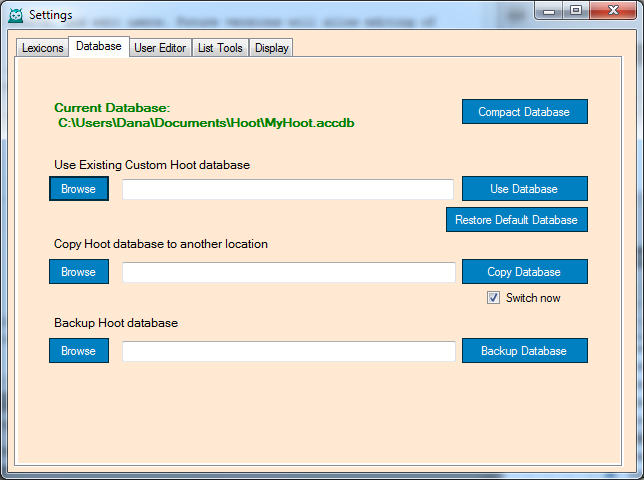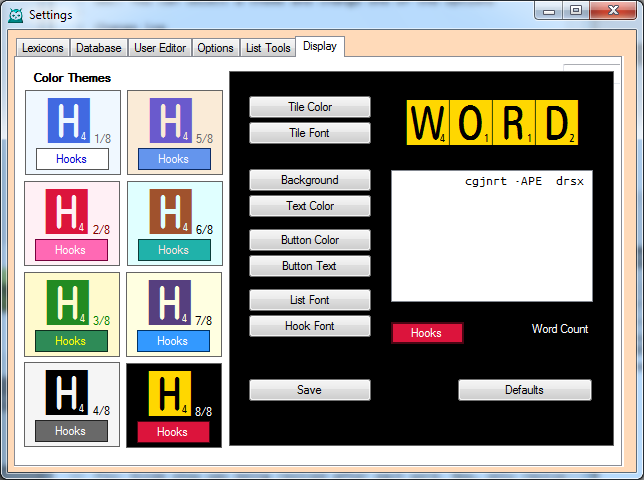Settings
The Settings window is where you can change lexicons, select the database source, and edit users, select Display settings, and use some of the List Tools available. Some of the settings are saved in a user config file and are reloaded each time you use Hoot.
Database Selection
In new installations, Hoot includes the Hoot database in Program Files and makes a copy of it in the Hoot folder in MyDocuments. Users also have the ability to select an alternate database. The database must have the proper tables in order for Hoot to be able to read it. After selecting a new database, close the settings window to allow the database to load. If the database doesn't load properly for some reason, Hoot will attempt to restore the original database connection. In order to restore the original database connection manually, you can run the program with the commandline option "/restore". Ideally the user would copy the existing database to a different location and make modifications such as adding lexicons and subject lists in order to customize it.
Hoot is designed to use either the mdb or accdb format Microsoft Access database, and switch between them (depending on your system's limitations).
Note: Hoot saves the location of the database you've selected to use. If a newer version (1.8.0+) includes a new database, it will be copied to Program Files, but will not be used until you select it or copy it to your selected location. Normally, you would use the same database and add new lexicons as desired.
Copy
The Database settings screen allows you to copy the current database to another location and then use it. This is important because the installed database cannot be edited because it is stored with the program. The alternate database can then be edited, adding other lexicons to the database. The default name for the Hoot database is Hoot.accdb or Hoot.mdb, but you can now use a different name as long as the extension is the same. In order to switch to the copied database immediately, check the Switch Now checkbox. Later versions automatically copy the database to the Hoot folder in the User's Documents folder.
I recommend using an alternate database. Using an alternate database means any changes you make are not overwritten by subsequent versions of Hoot. However, the alternate database will not include any improvements that might be made to the database, so you should save any source documents that you used to modify the database.
Backup
You can also make backups of the database. Backup filenaming defaults to including the date and time in the filespec. Backups can be saved in the Backups subfolder of your Hoot folder. Normally, this is Users\<User>\Documents\Hoot\Backups.
Compact and Repair
When adding and deleting large lexicons, data is only marked as deleted. In order to eliminate the marked data you can compact the database to save space. The Compact and Repair applies to the currently selected database. It is recommended that you backup the database before using Compact and Repair.
Lexicon Selection
The Lexicon selection screen also displays information about the selected lexicon. The lexicon being used is displayed on the top of the opening screen. Whether or not the lexicon has been indexed is displayed. Indexing takes 30-45 for long word lists like the TWL98. The lexicons provided with the program are already indexed. When you change the lexicon, all search screens are closed.
Information about each lexicon can be modified in this screen, and you now have the ability to export lexicons as well. When a lexicon is exported, it is saved as a tab-delimited text file, including the word, the front hooks, and the back hooks. This is one way you can share a lexicon with other Hoot users. Importing shared lexicons is a function of the Lexicon Creator. Keep in mind that sharing "copyrighted" lexicons could subject you to legal actions. You can now also delete lexicons from Hoot. Before doing so, you may want to export it just in case you want to use it later or share it with others.
User Editor
The User editor allows you to add multiple users to the program. When a user has logged in, Hoot can save known words for future study. This screen also allows you to see and/or clear a user's known words list. See the section on Slide Shows for more information about Known Word Management.
List Tools
This tab contains buttons to access some of the new features of Hoot which are described on separate pages.
The Prefix/Suffix Editor is a simple editor to add or delete prefixes and suffixed available in the dropdown list in the Begin/End screen.
Options
There are a couple of other options in Hoot, enable or disable inner hooks and change of user folder
Show Inner Hooks
With version 1.7.6 Hoot provides inner hook indicators. An inner hook is a letter than can be removed from a word to form another word. The inner hook is indicated with a bullet on whatever end the inner hook is on.
For example, the word ATE will be shown as ATE• indicating that the E can be removed to form the word AT. The word AHA is shown as •AHA• indicating that either the first letter or the last letter can be removed to form HA, AH respectively.
Version 1.7.6 was released with the default setting being to not show inner hooks. Later versions have the option enabled since it doesn't cause much delay on English lexicons. Using the 360,000+ word French lexicon, however, will be slower and some users may want to disable it.
List Limits
The list limits option allow you to limit the number of words shown in a list. While the default is not to limit words in a list, copyrighted lists may override this setting. This will generally not yet speed up searches with more the limited number of words. After changing the limit, select Save.
Word Length Limit
With version 1.7.9 and later you can also limit the length of words being returned in a search. The default is 15, but you can increase that to 21 for Super Scrabble™. You will need to use a lexicon that has the longer words, like Word Judge 2, in order to use it. You can also limit it to 9 or 10 as some dictionaries do. That may also spend some of the longer searches. After changing the length, select Save.
Select User Folder
Hoot will normally install the database in the Hoot folder in the MyDocuments folder, and creates a collection of subfolders for Searches, Lists, Lexicons, etc. With 1.7.6 users have the option of selecting a different folder as the user folder. This is useful if you want to keep Hoot resources close to other study tools and resources. While Hoot will create the necessary subfolders, it is up to the user to create the folder AND copy the database to that folder. The user will also have to copy any previously saved Searches, Lists, Lexicons, etc. The option is saved as a part of the Windows user profile, not on a Hoot user basis.
Display Settings
Basic display customizations are available here. This screen allows you to customize the program background, default text color, the button colors, the tile color, and the font to use in search results. The tiles used in slide shows in Hoot is the font "NuTiles." You can choose another font for the tile in Settings, although there are very few Scrabble like fonts available. During Hoot development I discovered that the font "Scramble" that I used for tiles in Hoot needs to be licensed.
When selecting a font for displaying words with hooks, a monospaced font is recommended to insure that the words align in the search results. When installed, Hoot uses Ubuntu Mono for hook displays. It's not that easy to spot monospaced fonts, so this list may be helpful. Most of these are either part of Windows or available as a free download.
- Anonymous Pro
- Courier
- Courier New
- Consolas
- DejaVu Sans Mono
- Fixedsys
- Inconsolata
- Letter Gothic Std
- Liberation Mono
- Lucida Console
- Orator Std
- Quicktype Mono
- Source Code Pro
Hoot (actually Windows) remembers your selections between sessions and even after updating. There is a reset to set all colors back to the default. The design and color of buttons on the display settings screen itself are fixed and can't be changed. This may help when you've set the color on all items the same and can't see anything. Hoot also will not allow you to set text or tile the same color as the background.
There is now a collection of color themes you can use for quick changes. Click on one of the samples and the colors are set accordingly. One of the themes draws from the user's Windows colors. After making any changes, remember to Save your settings then close the Settings window to see the changes in other windows.



